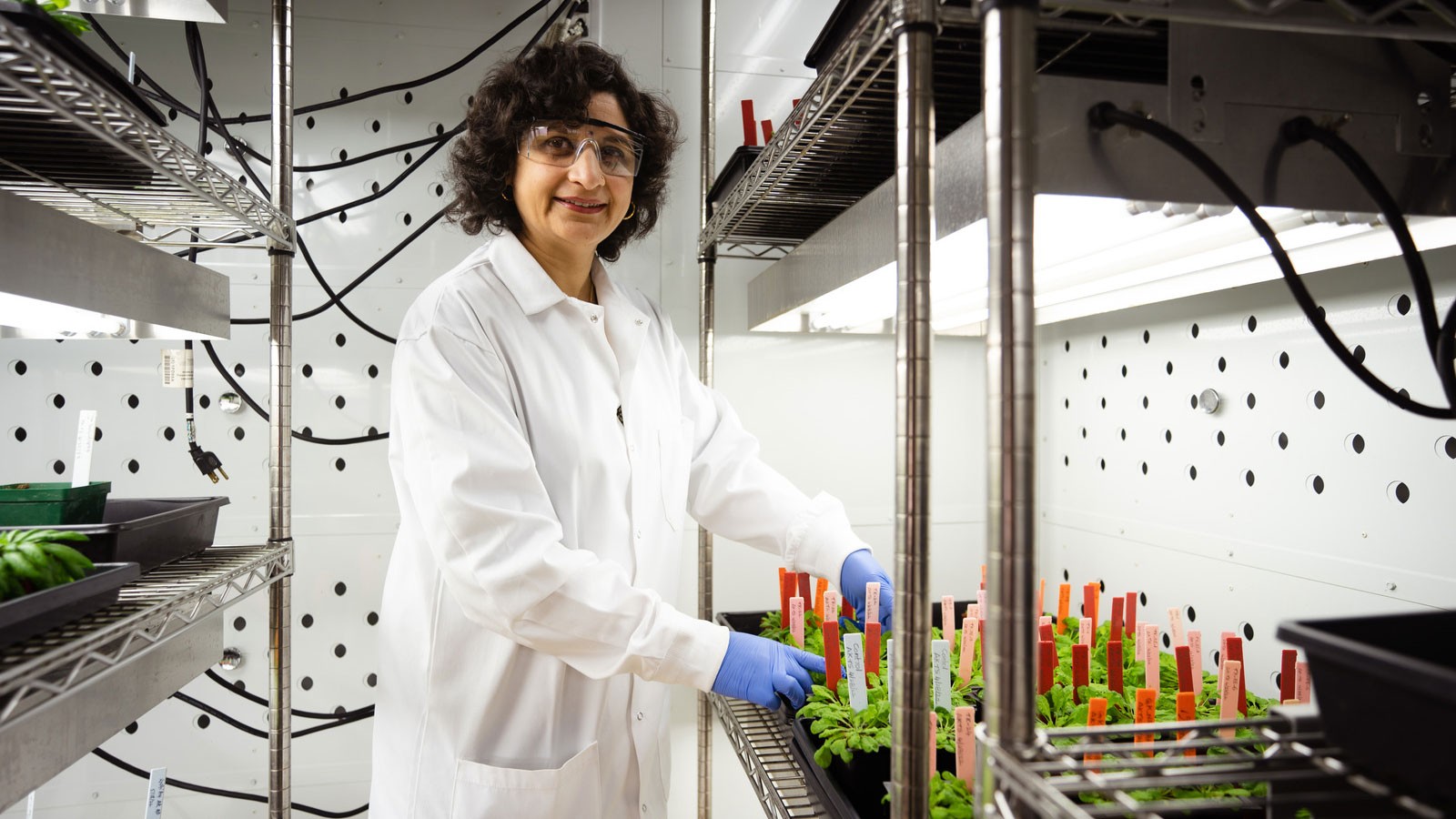USU Professor Awarded $850,000 USDA Grant to Study Plant-Growth Bacteria
By Ethan Brightbill |
Assistant Professor Amita Kaundal leads a research collaboration focused on how bacteria that promote growth in some native plants can be used to help crops withstand increasing salinity and drought conditions and improve soils. (Photo Credit: USU/Bronson Teichert)
A Utah State University molecular biologist, Assistant Professor Amita Kaundal, has received an $850,000 grant from the United States Department of Agriculture’s National Institute of Food and Agriculture to study how bacteria can promote plant growth even under drought or high-salt conditions.
Salt stress and drought are both on the rise as a result of climate change, and both pose significant challenges for agriculture. As groundwater and precipitation become scarcer, farmers must irrigate their fields more to grow crops. However, the water used in irrigation contains salts that get transferred to the soil and build up over time, which in turn hinders most plant growth. More than 20% of the world’s farmable land is already contaminated by salt, and that figure is set to grow over time even as the human population and demand for food rise.
That’s where Kaundal’s work in USU’s Department of Plants, Soils and Climate comes in. Plant growth-promoting bacteria (PGPB) can help farmers adapt to drought and salt stress conditions while improving soil health.
“Soil is not a dead material,” Kaundal said. “One gram of soil can contain around 10 billion microbes, and living soil is more fertile because of these bacteria. They help plants take up nutrients, fix atmospheric nitrogen, and even act as biocontrol agents. While chemical fertilizers and pesticides kill these microbes, PGPB increase not only plant health and crop production but also soil health.”
The project builds on Kaundal’s previous research and is a collaboration involving USU Professor and Extension Agronomist Earl Creech, environmental engineering Professor Ramesh Goel from the University of Utah, and Devinder Sandhu from the U.S. Salinity Laboratory in Riverside, California.
Kaundal and her fellow researchers chose to examine native plants near the Great Salt Lake to isolate salt-tolerant PGPB. For drought-tolerant bacteria, they will focus on snowbrush and mountain mahogany. Both plants are native to Utah, the second-driest state in the United States, and they quickly proved to be home to the bacteria the team is looking for. Once these microbes are isolated, they can offer new ways to help plants adapt to drier, saltier soil conditions.
“Gene-edited crops take a long time to create, and they have to be studied extensively before we release them for public use,” Kaundal said. “With PGPB, we know they don’t have side effects because they’re already present in the soil and helping plants. Why not use them as fertilizer?”
Gathering the bacteria requires going out to where mountain mahogany and snowbrush grow naturally.
“It’s a hike, so it’s fun,” said Kaundal. “And we don’t kill the plants. We just dig 30 centimeters down and expose the roots, which we collect carefully without messing anything up, and the bacteria are either inside these roots or on their surface in the attached soil.”
The root samples are brought back to the lab and sliced into pieces from which the bacteria are extracted. Researchers use different combinations of nutrients to grow and then isolate varieties of bacteria, which they identify with DNA sequencing.
From there, promising isolates are tested in growth chambers on thale cress, a plant often used in experiments because it is well understood and has a relatively short lifecycle.
Bacteria that show further potential are then tested on crops like corn, wheat and watermelon. If successful, they graduate to tests in greenhouses and then fields. Once the team is certain a strain is safe and productive, they can ask farmers to test it on their crops.
Kaundal and her colleagues are in the early stages of the project. Each step takes time, and there are many factors to consider along the way. For instance, in a potato plant grown with PGPB, the team looks for tuber growth, while in a leafy crop like spinach, they focus on foliage. Even so, Kaundal is optimistic about her work.
“Nature already has an answer for everything, only we don't always know what that is,” she said. “That’s why we need to make these discoveries.”
WRITER
Ethan Brightbill
Writer and Marketing Assistant
College of Veterinary Medicine
Ethan.Brightbill@usu.edu
CONTACT
Amita Kaundal
Assistant Professor of Molecular Biology/Microbiology
Department of Plants, Soils and Climate
435-797-0457
amita.kaundal@usu.edu
TOPICS
Research 878stories Grants 228stories Agriculture 225stories Plants 187stories Climate 151storiesComments and questions regarding this article may be directed to the contact person listed on this page.







